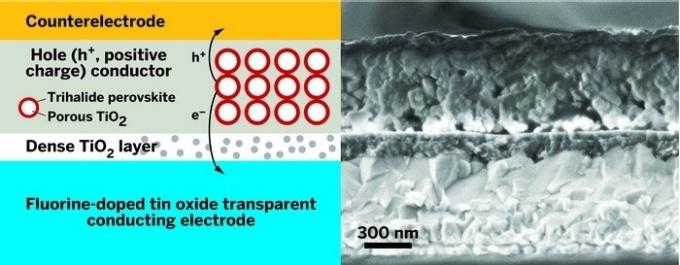
What are perovskites? Perovskite is a relatively inexpensive mineral composed of calcium titanate (titanate is a salt composed of titanium and oxygen). It is attracting attention in the renewable energy space for its semiconductor properties.
The Department of Energy announced $10 million in new research and development (R&D) funding for six research teams during the SunShot Grand Challenge Summit 2014 two weeks ago. The teams will use the funds to develop cheap, efficient thermochemical energy storage (TCES) solutions for utility-scale concentrating solar power (CSP) systems. For at least two of the six, perovskite minerals are to serve as the energy storage medium.
Finding a cheap, efficient means of storing energy produced by CSP plants would be a major milestone for the fast-growing renewable energy sector, and that's probably an understatement. Perovskites may be more than the key to cheap energy storage for CSP, however.
A class of lamellar organic-inorganic minerals found in igneous and metamorphic rocks, perovskites have generated intense interest among photovoltaic (PV) energy researchers as well.
A semiconductor, perovskite PV cells can essentially be “painted” on to almost any type of surface – flexible or rigid. Solar PV researchers having been making significant strides in boosting the energy conversion efficiency and lowering the cost of producing perovskite PV cells, leading one prominent researcher to assert that they “are poised to 'break the prevailing paradigm.'”
Perovskites and CSP energy storage
A total $4.45 million of the $10 million in CSP ELEMENTS program R&D funding announced by DOE during this year's SunShot Grand Challenge Summit is being allocated specifically to investigate the use of perovskites in CSP-thermochemical energy storage solutions.
Awarded $1 million, the Colorado School of Mines (CSM) will lead an R&D team that also includes Abengoa and the National Renewable Energy Laboratory (NREL). Joined by colleagues Robert Braun and Robert Kee, Prof. Greg Jackson, the head of CSM's mechanical engineering department, will lead a two-year R&D effort “to work on materials development and system design of the novel energy storage concept,” CSM explains in a news release.
Focusing more on commercial aspects, Abengoa's Christina Lopez is responsible for systems integration and techo-economic analysis. NREL's Zhiwn Ma will lead other research partners in an effort “to adapt NREL's near blackbody solar energy design to operate as a reactor for capturing the sun's energy as storable thermochemical energy in perovskite particles.”
Awarded R&D funding of $3.45 million, Sandia National Laboratories' Drs. James Miller, Andrea Ambrosini and Clifford Ho will lead research into a CSP-TCES solution in which the heat of concentrated sunlight is to be captured and stored by “a falling curtain” of perovskite particles. Researchers from Arizona State University, the Georgia Institute of Technology, and Saudi Arabia's King Saud University round out the R&D team.
Through the ELEMENTS program, DOE is looking to leverage public and private sector resources to develop CSP-TCES systems that can provide energy storage at a cost of $15 per kilowatt-hour-thermal (kWht) or less and can operate at temperatures greater than or equal to 650ºC (1170ºF).
Perovskites and solar PV
Besides CSP-TCES, solar PV researchers increasingly see perovskite PV cells as offering an ideal combination of price and performance. Energy conversion efficiency has jumped from a few to 16 percent, with 25 percent conversion efficiency considered easily within reach.
Furthermore, though not yet produced at commercial scale, all signs indicate that the cost of producing perovskite PV cells in bulk will be much lower than for c-Si PV cells, the cheapest and most efficient available on the global market today. Costs are coming down as researchers focus on using less expensive materials and improving production processes.
As Chemical & Engineering News (C&EN) reporter Mitch Jacoby quoted University of Notre Dame chemistry professor Prashant V. Kamat in a February 2014 article:
“The simplicity of making solar-cell components via liquid-phase chemical reactions and depositing the materials by methods such as spraying and spin coating may make it possible for solar-cell manufacturers to eventually replace clean rooms and sophisticated manufacturing equipment with simple benchtop processes.”
In that same article, C&EN reported on University of Oxford physicist Henry J. Snaith, who is looking to commercialize perovskite PV cell technology. Also the leader of the Oxford Photovoltaic & Optoelectronic Device Group, Snaif has launched Oxford Photovoltaics, which is focusing on developing building-integrated applications of perovskite PV cells.
Tempering all the enthusiasm a bit, Snaith told C&EN that “it’s tough to predict where this technology will end up.” Yet based on perovskites' inherent properties and the pace of recent R&D advances he added, “So long as we can improve the stability of this technology, I would say we are witnessing the emergence of a contender for ultimately low-cost solar power.”
*Image credits: 1) Wikimedia Commons; 2) Sandia National Laboratories ; 3) Journal of Physical Chemistry Letters

An experienced, independent journalist, editor and researcher, Andrew has crisscrossed the globe while reporting on sustainability, corporate social responsibility, social and environmental entrepreneurship, renewable energy, energy efficiency and clean technology. He studied geology at CU, Boulder, has an MBA in finance from Pace University, and completed a certificate program in international governance for biodiversity at UN University in Japan.














